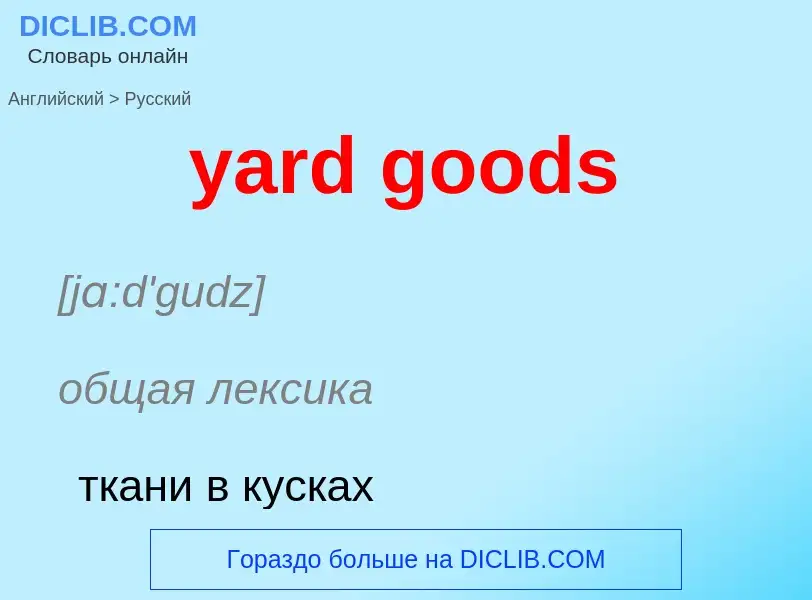Translation and analysis of words by ChatGPT artificial intelligence
On this page you can get a detailed analysis of a word or phrase, produced by the best artificial intelligence technology to date:
- how the word is used
- frequency of use
- it is used more often in oral or written speech
- word translation options
- usage examples (several phrases with translation)
- etymology
yard goods - translation to russian
[jɑ:d'gudz]
общая лексика
ткани в кусках
Definition
Wikipedia

Textile is an umbrella term that includes various fiber-based materials, including fibers, yarns, filaments, threads, different fabric types, etc. At first, the word "textiles" only referred to woven fabrics.: 3 : 5 However, weaving is not the only manufacturing method, and many other methods were later developed to form textile structures based on their intended use. Knitting and non-woven are other popular types of fabric manufacturing. In the contemporary world, textiles satisfy the material needs for versatile applications, from simple daily clothing to bulletproof jackets, spacesuits, and doctor's gowns.
Textiles are divided into two groups: consumer textiles for domestic purposes and technical textiles. In consumer textiles, aesthetics and comfort are the most important factors, while in technical textiles, functional properties are the priority.
Geotextiles, industrial textiles, medical textiles, and many other areas are examples of technical textiles, whereas clothing and furnishings are examples of consumer textiles. Each component of a textile product, including fiber, yarn, fabric, processing, and finishing, affects the final product. Components may vary among various textile products as they are selected based on their fitness for purpose.
Fiber is the smallest component of a fabric; fibers are typically spun into yarn, and yarns are used to manufacture fabrics. Fiber has a hair-like appearance and a higher length-to-width ratio. The sources of fibers may be natural, synthetic, or both. The techniques of felting and bonding directly transform fibers into fabric. In other cases, yarns are manipulated with different fabric manufacturing systems to produce various fabric constructions. The fibers are twisted or laid out to make a long, continuous strand of yarn. Yarns are then used to make different kinds of fabric by weaving, knitting, crocheting, knotting, tatting, or braiding. After manufacturing, textile materials are processed and finished to add value, such as aesthetics, physical characteristics, and increased usefulness. The manufacturing of textiles is the oldest industrial art. Dyeing, printing, and embroidery are all different decorative arts applied to textile materials.





![Bridal gown made from nettle fibers, probably worn by Eleonora Sophie Rantzau (1779-) at her wedding to [[Preben Bille-Brahe]], [[Hvedholm Castle]]. [[National Museum of Denmark]]. Bridal gown made from nettle fibers, probably worn by Eleonora Sophie Rantzau (1779-) at her wedding to [[Preben Bille-Brahe]], [[Hvedholm Castle]]. [[National Museum of Denmark]].](https://commons.wikimedia.org/wiki/Special:FilePath/Brudekjole, 1797.jpg?width=200)
![Sample of calico printed with a six-colour machine by Walter Crum & Co., from [[Frederick Crace Calvert]], ''Dyeing and Calico Printing'' (1878) Sample of calico printed with a six-colour machine by Walter Crum & Co., from [[Frederick Crace Calvert]], ''Dyeing and Calico Printing'' (1878)](https://commons.wikimedia.org/wiki/Special:FilePath/Calico sample Crum & Co..jpg?width=200)

![Kazakh]] felt [[yurt]] Kazakh]] felt [[yurt]]](https://commons.wikimedia.org/wiki/Special:FilePath/Kazah jurta.jpg?width=200)


![Nonwoven [[geotextile]] bags are much more robust than woven bags of the same thickness. Nonwoven [[geotextile]] bags are much more robust than woven bags of the same thickness.](https://commons.wikimedia.org/wiki/Special:FilePath/Nonwoven geotextile containers.jpg?width=200)
![[[Weaving]] [[Weaving]]](https://commons.wikimedia.org/wiki/Special:FilePath/Tzutujil.weaving.jpg?width=200)



![coat]], [[scarf]] and [[sweater]] coat]], [[scarf]] and [[sweater]]](https://commons.wikimedia.org/wiki/Special:FilePath/Well-clothed baby.jpg?width=200)
.jpg?width=200)
![Explosive Ordnance Disposal (EOD) suit]]. Explosive Ordnance Disposal (EOD) suit]].](https://commons.wikimedia.org/wiki/Special:FilePath/Übung Northern Coast.jpg?width=200)
![Textile market on the sidewalks of [[Karachi]], Pakistan Textile market on the sidewalks of [[Karachi]], Pakistan](https://commons.wikimedia.org/wiki/Special:FilePath/Karachi - Pakistan-market.jpg?width=200)

![Late antique textile, [[Egypt]]ian, now in the [[Dumbarton Oaks]] collection Late antique textile, [[Egypt]]ian, now in the [[Dumbarton Oaks]] collection](https://commons.wikimedia.org/wiki/Special:FilePath/DumbartonOaksTextileEuropa.jpg?width=200)
![Fortuny tea gown]] Fortuny tea gown]]](https://commons.wikimedia.org/wiki/Special:FilePath/Conde nast fortuny.jpg?width=200)
![Traditional [[tablecloth]], [[Maramureș]], [[Romania]] Traditional [[tablecloth]], [[Maramureș]], [[Romania]]](https://commons.wikimedia.org/wiki/Special:FilePath/Tablecloth romanian 1full view.jpg?width=200)
![Advertisement for Zepel, the trade name used to market [[Teflon]] as a fabric treatment Advertisement for Zepel, the trade name used to market [[Teflon]] as a fabric treatment](https://commons.wikimedia.org/wiki/Special:FilePath/1963 Zepel advertisement.jpg?width=200)

![Textile machinery at the Cambrian Factory, [[Llanwrtyd]], Wales, in the 1940s Textile machinery at the Cambrian Factory, [[Llanwrtyd]], Wales, in the 1940s](https://commons.wikimedia.org/wiki/Special:FilePath/Textile machinery at Cambrian Factory, Llanwrtyd (1293828).jpg?width=200)
![[[Cotton]] fiber [[Cotton]] fiber](https://commons.wikimedia.org/wiki/Special:FilePath/BALLS OF COTTON (ANDHRA -SOUTH INDIA) READY FOR HARVEST.jpg?width=200)

![hessian]], polycotton. hessian]], polycotton.](https://commons.wikimedia.org/wiki/Special:FilePath/Cloth 800.jpg?width=200)
![A textile factory in [[Israel]], [[1969]] A textile factory in [[Israel]], [[1969]]](https://commons.wikimedia.org/wiki/Special:FilePath/Dan Hadani collection (990044401360205171).jpg?width=200)
![Woven tartan of [[Clan Campbell]], [[Scotland]] Woven tartan of [[Clan Campbell]], [[Scotland]]](https://commons.wikimedia.org/wiki/Special:FilePath/Tartan Clan Campbell.png?width=200)

![A modern umbrella fabric has specific requirements for [[colour fastness]] to light, water and wet rubbing, and permeability. A modern umbrella fabric has specific requirements for [[colour fastness]] to light, water and wet rubbing, and permeability.](https://commons.wikimedia.org/wiki/Special:FilePath/M0354 000727-005 1.jpg?width=200)

![Clothing made of textiles, [[Thailand]] Clothing made of textiles, [[Thailand]]](https://commons.wikimedia.org/wiki/Special:FilePath/Chiang Mai, Thailand, Colorful clothing.jpg?width=200)
![Close-up view of a [[Barong Tagalog]] made with [[piña]] fiber in the [[Philippines]] Close-up view of a [[Barong Tagalog]] made with [[piña]] fiber in the [[Philippines]]](https://commons.wikimedia.org/wiki/Special:FilePath/Barong Up Close.jpg?width=200)
![A fabric tunnel in [[Moulvibazar District]], [[Bangladesh]] A fabric tunnel in [[Moulvibazar District]], [[Bangladesh]]](https://commons.wikimedia.org/wiki/Special:FilePath/Scene with Fabric Tunnel - Srimangal - Sylhet Division - Bangladesh (12904860703).jpg?width=200)
![A modern [[Manila hemp]] made on industrial weaving machines A modern [[Manila hemp]] made on industrial weaving machines](https://commons.wikimedia.org/wiki/Special:FilePath/49-QWSTION-BANANATEX-FABRIC.jpg?width=200)

![Park Lane Goods Terminus]] at Liverpool's docks was the world's first station built entirely for freight. Park Lane Goods Terminus]] at Liverpool's docks was the world's first station built entirely for freight.](https://commons.wikimedia.org/wiki/Special:FilePath/09 Warehouses etc at the end of the Tunnel towards Wapping, from Bury's Liverpool and Manchester Railway, 1831 - artfinder 267568.jpg?width=200)
![Old freight depot building in [[Tampere]], [[Finland]] before relocation in 2020 Old freight depot building in [[Tampere]], [[Finland]] before relocation in 2020](https://commons.wikimedia.org/wiki/Special:FilePath/Tavara-asema tre 02.jpg?width=200)
